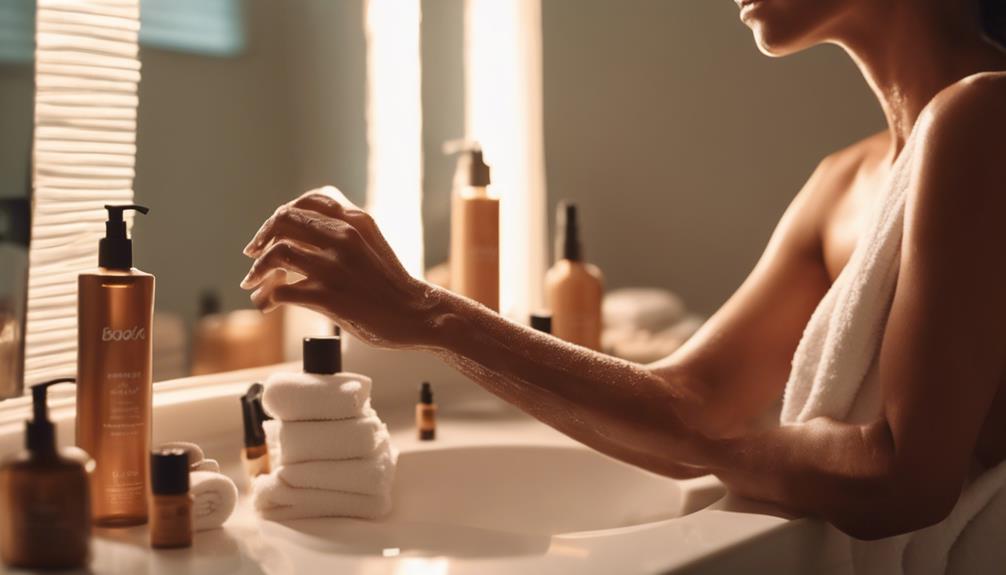You can totally reveal your perfect indoor tan today—no sunburns required! Start by picking a good indoor tanning lotion packed with ingredients like DHA and Tyrosine to boost that gorgeous glow. Don't forget to hydrate your skin; it loves that moisture and will thank you later. And hey, applying it in smooth circles makes all the difference for an even tan! Just watch out for those tricky spots like elbows and knees. So, ready to strut your stuff with that stunning bronzed look? Stick around, and you'll uncover even more tips to elevate your tanning game!
Key Takeaways
- Choose the right indoor tanning lotion with key ingredients like DHA and Tyrosine for optimal color and depth.
- Stay hydrated by drinking water and using moisturizers to keep skin healthy and enhance your tan.
- Exfoliate and moisturize your skin before tanning to prevent uneven results and ensure a smooth application.
- Apply lotion in circular motions, focusing on tricky areas, and allow it to absorb before dressing.
Overview of Indoor Tanning Lotions
Indoor tanning lotions are essential tools for achieving a beautiful, bronzed look without the harmful effects of UV exposure. You know that feeling of wanting a sun-kissed glow, but without the risk of sunburn? That's where these lotions come in!
They're designed to give you that instant tan, and the best part? No streaks or patches! You can choose from different types, like bronzers or accelerators, depending on your skin's needs.
Plus, these lotions keep your skin hydrated, which is super important. Who wants dry, flaky skin, right?
Essential Ingredients for Tanning

To achieve that perfect tan, understanding the key ingredients in tanning lotions can make all the difference in your results.
First up is DHA, which gives you that instant color that keeps getting better.
Next, there's tyrosine, a little helper that boosts melanin production for a deeper glow.
Ever heard of caffeine in your lotion? It's not just for your morning coffee; it helps reduce puffiness and energizes your skin.
Don't forget moisturizers like Vitamin E and Aloe Vera—they keep your skin hydrated and happy. After all, nobody wants a dry tan, right?
Importance of Hydration

Staying hydrated is key to achieving and maintaining a radiant tan. You might be thinking, 'But why water?' Well, your skin craves moisture just like you crave pizza on a Friday night!
When you drink enough water, your skin stays plump and elastic, which helps your tan look even better. Plus, hydrated skin can boost melanin production, giving you that rich, golden glow.
Don't forget to moisturize before, during, and after tanning, too! It'll help prevent peeling, and nobody wants a patchy tan, right?
Guidelines for Tanning Sessions

Keeping your skin hydrated sets the stage for successful tanning sessions, ensuring you achieve that perfect glow while minimizing the risk of damage.
Start by keeping your sessions short at first—think of it like dipping your toes in the pool, not cannonballing right away!
Avoid tanning between 10 AM and 4 PM; that's when the sun's rays are like a grumpy toddler—way too intense!
Pay attention to your skin's sensitivity; if you're on the sensitive side, shorter is better.
Remember to give your skin some love—moisturize before and after to keep it happy.
And hey, don't forget to enjoy the process! Tanning should be fun, not a race.
Dietary Choices for Better Tans

Eating a diet rich in beta-carotene and healthy fats can greatly enhance your tanning results. When you munch on colorful fruits and veggies, like carrots and sweet potatoes, you're not just being healthy; you're prepping your skin for a gorgeous glow! Pair those with healthy fats from avocados and nuts, and you're golden. Check out the table below for some tasty options:
| Food | Benefits | Tips |
|---|---|---|
| Carrots | High in beta-carotene | Snack raw or in salads |
| Spinach | Rich in vitamins | Add to smoothies |
| Avocados | Healthy fats | Spread on toast |
| Sweet Potatoes | Great for skin health | Bake or mash |
| Oranges | Boosts collagen production | Enjoy as a revitalizing snack |
Effective Application Techniques

To achieve an even and flawless tan, it's essential to apply indoor tanning lotion using smooth, circular motions, ensuring full coverage without missing any areas.
Think of it like spreading peanut butter on toast—no one wants a patchy sandwich, right? Start with small amounts of lotion to avoid overwhelming your skin.
Don't forget those tricky spots, like your elbows and knees; they can be sneaky! You might want to use gloves or wash your hands right after, unless you're going for that “just rolled in a chocolate factory” look.
And remember, patience is key! Let the lotion soak in before putting on clothes.
Trust me, a little extra care now leads to a tan that'll have you glowing!
Common Tanning Mistakes to Avoid

Many people make common mistakes while tanning that can lead to uneven results or skin damage.
First off, skipping the prep work is a big no-no! You wouldn't bake a cake without mixing the ingredients, right? Always exfoliate and moisturize before tanning.
Also, don't overdo it! More tanning doesn't mean a better tan; it can just lead to burns. And remember to wash your hands after applying bronzer—no one wants orange palms!
Another mistake? Ignoring hydration. Drink water and use moisturizing lotion to keep your skin happy.
Finally, don't forget to check your tanning lotion's expiration date. Using old products can leave you looking patchy.
Keep these tips in mind, and you'll be glowing in no time!
Frequently Asked Questions
Can Indoor Tanning Lotions Expire, and How Can I Tell?
Yes, indoor tanning lotions can expire. Check for changes in color, consistency, or scent. If the lotion feels dry or clumpy, it's best to discard it to guarantee effective and safe tanning results.
Are Indoor Tanning Lotions Safe for All Skin Types?
Indoor tanning lotions aren't universally safe; it depends on your skin type. You should patch-test before full application, ensuring you avoid irritation. Choose products suited for your specific skin needs to achieve ideal results.
How Often Should I Apply Indoor Tanning Lotion for Best Results?
You should apply indoor tanning lotion every few days for ideal results. This frequency allows your skin to absorb the ingredients while maintaining an even, rich tan without risking irritation or uneven patches.
Can I Use Indoor Tanning Lotion With Self-Tanner?
Sure, you can mix indoor tanning lotion with self-tanner, because who doesn't love a little extra color confusion? Just remember to apply them carefully to avoid looking like a patchy mess. Happy tanning!
Are There Any Side Effects Associated With Indoor Tanning Lotions?
Yes, indoor tanning lotions can cause side effects like skin irritation, allergic reactions, or uneven color. You should always perform a patch test and follow the instructions to minimize risks and achieve the best results.
Conclusion
So, there you have it! With the right indoor tanning products and a sprinkle of care, you can achieve that golden glow you've been dreaming of.
Think of your tan like a great pizza—you need the right ingredients, a little time, and some love to make it just right.
Remember to stay hydrated, apply those lotions like a pro, and avoid common pitfalls.
Now, go ahead and flaunt that radiant tan—you deserve it!
Happy tanning!










